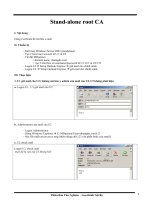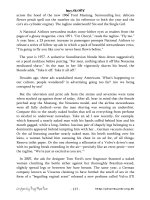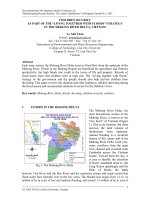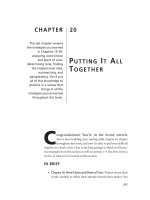Alone together
Bạn đang xem bản rút gọn của tài liệu. Xem và tải ngay bản đầy đủ của tài liệu tại đây (1.7 MB, 458 trang )
TableofContents
ALSOBYSHERRYTURKLE
TitlePage
Dedication
Epigraph
AUTHOR’SNOTE
Introduction
PARTONE-TheRoboticMoment
CHAPTER1-Nearestneighbors
LIFERECONSIDERED
THETAMAGOTCHIPRIMER
UNFORGETTABLE
CHAPTER2-Aliveenough
WHATDOESAFURBYWANT?
OPERATINGPROCEDURES
ANETHICALLANDSCAPE
FROMTHEROMANTICREACTIONTOTHEROBOTICMOMENT
CHAPTER3-Truecompanions
SPAREPARTS
GROWINGUPAIBO
FROMBETTERTHANNOTHINGTOBETTERTHANANYTHING
SIMULTANEOUSVISIONSANDCOLDCOMFORTS
CHAPTER4-Enchantment
FROMMYREALBABYTOMYREALBABYSITTER
DON’TWEHAVEPEOPLEFORTHESEJOBS?
RORSCHACHTORELATIONSHIP
CHAPTER5-Complicities
MECHANICALTODDLERS
BUILDINGA“THOU”THROUGHTHEBODY
BUILDINGATHOUTHROUGHAFACEANDAVOICE
BUILDINGATHOUBYCARING
BUILDINGATHOUINDISAPPOINTMENTANDANGER
AGAIN,ONANETHICALTERRAIN
CHAPTER6-Love’slaborlost
CARINGMACHINES
CURINGALIFE
COACHINGASCURE
“ABEAUTIFULTHING”
“AROBOTTHATEVENSHERRYWILLLOVE”
DOROBOTSCURECONSCIENCE?
CHAPTER7-Communion
AMOMENTOFMORE:THEDANCERANDTHEDANCE
AMOMENTOFMORE:MERGINGMINDANDBODY
THROUGHTHEEYESOFTHEROBOT
CONSIDERINGTHEROBOTFORREAL
PARTTWO-Networked
CHAPTER8-Alwayson
THE NEW STATE OF THE SELF: TETHERED AND MARKED
ABSENT
THENEWSTATEOFTHESELF:FROMLIFETOTHELIFEMIX
THE NEW STATE OF THE SELF: MULTITASKING AND THE
ALCHEMYOFTIME
FEARFULSYMMETRIES
CHAPTER9-Growinguptethered
DEGREESOFSEPARATION
THECOLLABORATIVESELF
THEAVATAROFME
PRESENTATIONANXIETY
CHAPTER10-Noneedtocall
AUDREY:ALIFEONTHESCREEN
WHATHAPPENSONFACEBOOK,STAYSON...?
FINERDISTINCTIONS
OVERWHELMEDACROSSTHEGENERATIONS
VOICES
CHAPTER11-Reductionandbetrayal
SERIOUSPLAY:ASECONDLIFE
LIFEONTHESCREEN
ADAM
TEMPTATION
CHAPTER12-Trueconfessions
VENTING
THECRUELTYOFSTRANGERS
SEEKINGCOMMUNITIES
AFTERCONFESSION,WHAT?
CHAPTER13-Anxiety
RISKMANAGEMENT
WHAT’SITALLABOUT?
HIDEANDSTALK
PRIVACYANDTHEANXIETIESOFALWAYS
PRIVACYHASAPOLITICS
CHAPTER14-Thenostalgiaoftheyoung
ATTENTION
SPONTANEITY
THEPERILSOFPERFORMANCE
WALDEN2.0
CONCLUSION
EPILOGUE
NOTES
INDEX
CopyrightPage
ALSOBYSHERRYTURKLE
PsychoanalyticPolitics
TheSecondSelf
LifeontheScreen
EvocativeObjects(Ed.)
FallingforScience(Ed.)
TheInnerHistoryofDevices(Ed.)
SimulationandItsDiscontents
TOREBECCA
Mylettertoyou,withlove
“Everythingthatdeceivesmaybesaidtoenchant.”
—Plato,TheRepublic
“I’m done with smart machines. I want a machine that’s attentive to my needs. Where are the
sensitivemachines?”
—Tweetavailableatdig_natRT@tigoevia@ramonapringle
AUTHOR’SNOTE
Turningpoints
Thirtyyearsago,whenIjoinedthefacultyatMITtostudycomputerculture,the
worldretainedacertaininnocence.Childrenplayedtic-tac-toewiththeir
electronictoys,videogamemissilestookoninvadingasteroids,and“intelligent”
programscouldholduptheirendofaseriouschessmatch.Thefirsthome
computerswerebeingboughtbypeoplecalledhobbyists.Thepeoplewho
boughtorbuiltthemexperimentedwithprogramming,oftenmakingtheirown
simplegames.Nooneknewtowhatfurtheruseshomecomputersmightbeput.
Theintellectualbuzzinthestill-youngfieldofartificialintelligencewasover
programsthatcouldrecognizesimpleshapesandmanipulateblocks.AI
scientistsdebatedwhethermachinesofthefuturewouldhavetheirsmarts
programmedintothemorwhetherintelligencemightemergefromsimple
instructionswrittenintomachinehardware,justasneurobiologistscurrently
imaginethatintelligenceandreflectiveself-consciousnessemergefromthe
relativelysimplearchitectureandactivityofthehumanbrain.
NowIwasamongthemand,likeanyanthropologist,somethingofastranger
inastrangeland.IhadjustspentseveralyearsinParisstudyinghow
psychoanalyticideashadspreadintoeverydaylifeinFrance—howpeoplewere
pickingupandtryingonthisnewlanguageforthinkingabouttheself.Ihad
cometoMITbecauseIsensedthatsomethingsimilarwashappeningwiththe
languageofcomputers.Computationalmetaphors,suchas“debugging”and
“programming,”werestartingtobeusedtothinkaboutpolitics,education,
sociallife,and—mostcentraltotheanalogywithpsychoanalysis—aboutthe
self.Whilemycomputersciencecolleagueswereimmersedingettingcomputers
todoingeniousthings,Ihadotherconcerns.Howwerecomputerschangingus
aspeople?Mycolleaguesoftenobjected,insistingthatcomputerswere“just
tools.”ButIwascertainthatthe“just”inthatsentencewasdeceiving.Weare
shapedbyourtools.Andnow,thecomputer,amachineontheborderof
becomingamind,waschangingandshapingus.
Asapsychoanalyticallytrainedpsychologist,IwantedtoexplorewhatIhave
calledthe“innerhistoryofdevices.”1Discoveringaninnerhistoryrequires
listening—andoftennottothefirststorytold.Muchislearnedfromthetossedoffaside,thecommentmadewhentheinterviewis“officially”over.Todomy
work,IadoptedanethnographicandclinicalstyleofresearchasIlivedin
worldsnewtome.Butinsteadofspendinghundredsofhoursinsimple
dwellings,asananthropologistinatraditionalsettingwoulddo,listeningtothe
locallore,Ilurkedaroundcomputersciencedepartments,homecomputer
hobbyistclubs,andjuniorhighschoolcomputerlaboratories.Iaskedquestions
ofscientists,homecomputerowners,andchildren,butmostlyIlistenedtohow
theytalkedandwatchedhowtheybehavedamongtheirnew“thinking”
machines.
Iheardcomputersprovokeeruditeconversations.Perhaps,peoplewondered,
thehumanmindisjustaprogrammedmachine,muchlikeacomputer.Perhapsif
themindisaprogram,freewillisanillusion.Moststrikingly,these
conversationsoccurrednotjustinseminarrooms.Theyweretakingplace
aroundkitchentablesandinplayrooms.Computersbroughtphilosophyinto
everydaylife;inparticular,theyturnedchildrenintophilosophers.Inthe
presenceoftheirsimpleelectronicgames—gamesthatplayedtic-tac-toeor
challengedtheminspelling—childrenaskedifcomputerswerealive,iftheyhad
differentwaysofthinkingfrompeople,andwhat,intheageofsmartmachines,
wasspecialaboutbeingaperson.
Inthelate1970sandearly1980s,Iwitnessedamomentwhenwewere
confrontedwithmachinesthatinvitedustothinkdifferentlyabouthuman
thought,memory,andunderstanding.Thecomputerwasanevocativeobjectthat
provokedself-reflection.Forme,thiswascapturedinaconversationIhadwith
thirteen-year-oldDeborahintheearly1980s.Afterayearofstudying
programming,Deborahsaidthat,whenworkingwiththecomputer,“there’sa
littlepieceofyourmindandnowit’salittlepieceofthecomputer’smind.”
Oncethiswasachieved,youcouldseeyourself“differently.”2Face-to-“face”
withacomputer,peoplereflectedonwhotheywereinthemirrorofthemachine.
In1984,thinkingaboutDeborah(andinhomageaswelltoSimonede
Beauvoir),IcalledmyfirstbookoncomputersandpeopleTheSecondSelf.
Thatdate,1984,isofcourseiconicinWesternintellectualthinking,tethered
asitistoGeorgeOrwell’snovel.NineteenEighty-Fourdescribesasocietythat
subjectspeopletoconstantgovernmentsurveillance,publicmindcontrol,and
lossofindividualrights.Ifinditironicthatmyown1984book,aboutthe
technologythatinmanyasciencefictionnovelmakespossiblesuchadystopian
world,wasbycontrastfullofhopeandoptimism.Ihadconcernsaboutthe
“holdingpower”ofthenewtechnology:somepeoplefoundcomputersso
compellingthattheydidnotwanttobeseparatedfromthem.AndIworried
whetherlosingoneselfinworldswithinthemachinewoulddistractusfrom
facingourproblemsinthereal—bothpersonalandpolitical.But,inthisfirst
work,Ifocusedonhowevocativecomputersfosterednewreflectionaboutthe
self.
InthedecadefollowingthepublicationofTheSecondSelf,people’s
relationshipswithcomputerschanged.Whereasinthe1980sthatrelationship
wasalmostalwaysone-on-one,apersonalonewithamachine,inthe1990s,this
wasnolongerthecase.Bythen,thecomputerhadbecomeaportalthatenabled
peopletoleadparallellivesinvirtualworlds.Peoplejoinednetworkssuchas
AmericaOnlineanddiscoveredanewsenseof“place.”Thesewereheadytimes:
wewerenolongerlimitedtohandfulsofclosefriendsandcontacts.Nowwe
couldhavehundreds,eventhousands,adazzlingbreadthofconnection.My
focusshiftedfromtheone-on-onewithacomputertotherelationshipspeople
formedwitheachotherusingthecomputerasanintermediary.
IbeganthrowingweeklypizzapartiesintheBostonareatomeetpeoplewho
couldtellmethestoriesoftheirlivesinthenewvirtualworlds.Theydescribed
theerosionofboundariesbetweentherealandvirtualastheymovedinandout
oftheirlivesonthescreen.Viewsofselfbecamelessunitary,moreprotean.I
againfeltwitness,throughtheprismoftechnology,toashiftinhowwecreate
andexperienceourownidentities.
Ireportedonthisworkinmy1995LifeontheScreen,whichoffered,on
balance,apositiveviewofnewopportunitiesforexploringidentityonline.But
bythen,myoptimismof1984hadbeenchallenged.Iwasmeetingpeople,many
people,whofoundonlinelifemoresatisfyingthanwhatsomederisivelycalled
“RL,”thatis,reallife.Doug,aMidwesterncollegestudent,playedfouravatars,
distributedacrossthreedifferentonlineworlds.Healwayshadtheseworlds
openaswindowsonhiscomputerscreenalongwithhisschoolwork,e-mail
program,andfavoritegames.Hecycledeasilythroughthem.HetoldmethatRL
“isjustonemorewindow.”And,headded,“it’snotusuallymybestone.”3
Wherewasthisleading?
Twoavenuesforwardbecameapparentbythemid-1990s.Thefirstwasthe
developmentofafullynetworkedlife.Accesstothenetworknolongerrequired
thatweknowourdestination.Withbrowsersandsearchengines—Mosaic,
Netscape,InternetExplorer,Google—onehadthesenseoftraversinganinfinite
landscapealwaystheretobediscovered.AndasconnectionstotheInternetwent
mobile,wenolonger“loggedon”fromadesktop,tetheredbycablestoanobject
calleda“computer.”Thenetworkwaswithus,onus,allthetime.So,wecould
bewitheachotherallthetime.Second,therewasanevolutioninrobotics.Now,
insteadofsimplytakingondifficultordangerousjobsforus,robotswouldtryto
beourfriends.Thefruitsofsuchresearchmadetheirwayintochildren’s
playrooms:bythelate1990s,childrenwerepresentedwithdigital“creatures”
thatmadedemandsforattentionandseemedtopayattentiontothem.
AloneTogetherpicksupthesetwostrandsinthestoryofdigitalcultureover
thepastfifteenyears,withafocusontheyoung,thosefromfivethroughtheir
earlytwenties—“digitalnatives”growingupwithcellphonesandtoysthatask
forlove.If,bytheendofresearchingLifeontheScreen,Iwastroubledabout
thecostsoflifewithsimulation,inthecourseofresearchingthisbook,my
concernshavegrown.Thesedays,insecureinourrelationshipsandanxious
aboutintimacy,welooktotechnologyforwaystobeinrelationshipsandprotect
ourselvesfromthematthesametime.Thiscanhappenwhenoneisfinding
one’swaythroughablizzardoftextmessages;itcanhappenwheninteracting
witharobot.Ifeelwitnessforathirdtimetoaturningpointinourexpectations
oftechnologyandourselves.Webendtotheinanimatewithnewsolicitude.We
feartherisksanddisappointmentsofrelationshipswithourfellowhumans.We
expectmorefromtechnologyandlessfromeachother.
InthisbookIconcentrateonobservationsduringthepastfifteenyears,butI
alsoreachbacktotheprehistoryofrecentdevelopments.Totellthestoryof
artifactsthatencouragerelationship,IbeginwiththeELIZAprograminthe
1970sandtakethestorythroughtothe“sociable”humanoidrobots,suchas
DomoandMertz,builtatMITinthe2000s.Alongthewaytherehavebeen
manyotherdigital“creatures,”includingTamagotchis,Furbies,AIBOs,MyReal
Babies,Kismet,Cog,andParos,theselast,robotbabysealsdesigned
specificallytoprovidecompanionshipfortheelderly.Ithankthemorethan250
peopleinvolvedinmyrobotstudies.SomewhometrobotscametoMIT;other
timesIbroughtrobotstoschools,after-schoolcenters,andnursinghomes.When
workingwithchildren,wheneverpossible,Iprovidedthemwitharobottotake
homeforseveralweeks.Childrenandtheirfamilieswereaskedtokeep“robot
diaries,”accountsofhomelifewithanAIBO,MyRealBaby,orFurby.
Inthestoryofcomputer-mediatedcommunication,Ibeganmyinvestigations
inthe1980sandearly1990swithe-mail,bulletinboards,InternetRelayChat,
andAmericaOnlineandwentonfromtheretothefirstvirtualcommunitiesand
multiuseronlinerole-playinggames.Overthepastdecade,asthenetwork
dramaticallychangeditscontours,Ibroadenedmyinvestigationtoinclude
mobiledevices,texts,instantmessages,socialnetworks,Twitter,andmassively
multiplayeronlinegames.Myworkalsoincludedstudiesofvirtualcommunities
wherethree-dimensionalavatarsinhabitphotorealisticspaces.
Thefocusofmyresearchonnetworkingwastheyoung,andsoIdidmostof
myobservationsinhighschoolsandoncollegecampuses.ButIalsospokewith
adultswhogavemeinsightintohowthenetworkischangingparentingand
communicationspatternsinfieldsfromarchitecturetomanagementconsulting.
Over450peoplehaveparticipatedinmystudiesofconnectivity,roughly300
childrenand150adults.Ithankeveryonewholenttheirvoicestothisworkover
thepastfifteenyears.Iamgratefulfortheirgenerosityandgoodwill.
Theworkreportedonhere,asallofmywork,includesfieldresearchand
clinicalstudies.Infieldresearch,onegoestowherepeopleandtheir
technologiesmeettoobserveinteractions,sometimesaskquestions,andtake
detailednotes.Dependingonthenatureofthefieldsetting,casualconversations
maytakeplaceovercoffeeoroversnacksofmilkandcookies.Iteachcourses
aboutthecomputercultureandthepsychologyofcomputation,andsomeofmy
materialcomesfromthegive-and-takeoftheclassroom.Intheclinical
componentofmywork,Ipursuemoredetailedinterviews,usuallyinanofficeor
otherquietsetting.Icallthesestudiesclinical,butofcoursemyroleinthemis
asaresearcher,notatherapist.Myinterestinthe“innerhistory”oftechnology
meansthatItrytobringtogetherthesensibilityofethnographerandclinicianin
allmywork.Asensitiveethnographerisalwaysopentotheslip,toatear,toan
unexpectedassociation.Ithinkoftheproductasanintimateethnography.
Inmystudiesofrobots,Iprovidedtheartifacts(fromprimitiveTamagotchis
andFurbiestosophisticatedrobotssuchasKismetandCog).ThismeantthatI
wasabletostudychildrenandseniorsfromarangeofsocialandeconomic
backgrounds.Intheresearchonthenetworkedlife,Ididnotdistributeany
technology.Ispoketochildren,adolescents,andadultswhoalreadyhadWeb
accessandmobilephones.Necessarily,myclaimsaboutnewconnectivity
devicesandtheselfapplytothosewhocanaffordsuchthings.Thisturnedoutto
bealargergroupthanIhadoriginallysupposed.Forexample,inapublichigh
schoolstudyinthespringof2008,everystudent,acrossawiderangeof
economicandculturalsituations,hadamobilephonethatcouldsupporttexting.
MoststudentshadphonesthatcouldputthemontheWeb.Iamstudyinga
movingtarget.InJanuary2010,aNielsonstudyreportedthattheaverageteen
sendsoverthreethousandtextmessagesamonth.4Mydatasuggeststhatthis
numberissteadilyincreasing.WhatIreporthereisnothinglessthanthefuture
unfolding.a
Myinvestigationscontinue.Thesedays,parentswaitinlinetobuytheir
childreninteractiveZhuZhuroboticpethamsters,advertisedas“livingtofeel
thelove.”AndoneofthehottestonlineprogramsisChatroulette,with1.5
millionusers,whichrandomlyconnectsyoutootherusersallovertheworld.
Youseeeachotheronlivevideo.Youcantalkorwritenotes.Peoplemostlyhit
“next”afterabouttwosecondstobringanotherpersonupontheirscreens.It
seemsrightthatZhuZhupetsandChatroulettearethefinal“objects”Ireporton
inthisbook:theZhuZhusaredesignedtobeloved;inChatroulette,peopleare
objectifiedandquicklydiscarded.Ileavemystoryatapointofdisturbing
symmetry:weseemdeterminedtogivehumanqualitiestoobjectsandcontent
totreateachotherasthings.
Ipreservemysubjects’anonymitybychangingidentifyingdetails,except
whereIcitescientistsandresearchersonthepublicrecordorthosewhohave
askedtobecitedbyname.Withoutmentioning“real”namesandplaces,I
expressappreciationtoeveryonewhohasspokenwithmeandtotheschool
directorsandprincipals,teachers,andnursinghomedirectorsandstaffwho
mademyworkpossible.Istudiedrobotsintwonursinghomesandhavedata
fromstudentsinsevenhighschools(twopublicandcoeducational;fiveprivate,
oneforgirls,twoforboys,onecoeducational;andonecoeducationalCatholic
highschool).InsomecasesIhavebeenabletofollowchildrenwhogrewup
withTamagotchisandFurbiesthroughtheiradolescenceandyoungadulthoodas
theyenteredthenetworkedculturetobecomefluentwithtexting,Twitter,
MySpace,Facebook,andtheworldofiPhoneapps.Ithanktheseyoungadults
fortheirpatiencewithmeandthisproject.
IdidmuchoftheworkreportedhereundertheauspicesoftheMITInitiative
onTechnologyandSelf.Ithankallofmycolleaguesandstudentswhoworked
withtheinitiativeandintheProgramforScience,Technology,andSociety,
whichisitsacademichome.Ihaveprofitedfromtheirsupportandgoodideas.
CollegialrelationshipsacrossMIThaveenrichedmythinkingandbeen
sourcesofmuchappreciatedpracticalassistance.RodneyBrooksprovidedme
withanofficeattheMITArtificialIntelligenceLaboratorytohelpmegetthelay
oftheland.Hegavemethebestpossiblestart.CynthiaBreazealandBrian
Scassellati,theprincipaldevelopersofKismetandCog,workedwithmeonthe
first-encountersstudythatintroducedsixtychildrentotheserobots.Thesetwo
generouscolleagueshelpedmetothinkthroughsomanyoftheissuesinthis
book.Onthisstudy,IworkedwithresearchassistantsAnitaSayChan,Rebecca
Hurwitz,andTamaraKnutsen,andlaterwithRobertBriscoeandOliviaDasté.
TheKismetandCogsupportteam,includingLijinAryananda,AaronEdsinger,
PaulFitzpatrick,MatthewMarjanavic,andPaulinaVarchavskaia,provided
muchneededassistance.Attheverybeginningofmyresearchonvirtualworlds,
IworkedwithAmyBruckman.Forme,itwasatouchstonecollaboration.
JenniferAudley,JoannaBarnes,RobertBriscoe,OliviaDasté,AliceDriscoll,
CoryKidd,AnnePollack,RachelPrentice,JocelynScheirer,T.L.Taylor,and
WilliamTaggartallmadepreciouscontributionsduringtheyearsofinterviews
withchildren,families,andelders.IworkedwithFedericoCastelegnoatMITon
astudyofonlinegaming;Ithankhimforhisinsights.
Inthisdiverseandtalentedgroup,fourcolleaguesdeservespecialrecognition:
JenniferAudleyworkedonthisprojectfromtheearlieststudiesofTamagotchis
andFurbiesthroughtheworkontherobotsKismetandCog.OliviaDastéjoined
theprojectin2001,workingcloselywithmeinnursinghomesandschoolsand
ontheanalysisofthe“firstencounters”ofKismetandCog.WilliamTaggartand
CoryKiddworkedinnursinghomes,primarilywiththeParorobot.Eachof
themhasmydeepestthanks.
IalsoamgratefultoProfessorsCarolineJones,SeymourPapert,Mitchel
Resnick,WilliamMitchell,RosalindPicard,andWilliamPorter.Conversations
witheachofthembroughtnewideas.FormythinkingaboutDomoandMertz,
thankstoPiaLindman,AaronEdsinger,andLijinAryanandaofMIT’s
ComputerScienceandArtificialIntelligenceLaboratory(theArtificial
IntelligenceLaboratory’ssuccessor)whosharedtheirexperiencesandtheir
robotswithme.Conversationswithfivepsychoanalyticcolleagueswere
particularlyimportantinshapingmythinkingonchildrenandthecultureof
simulation,bothonlineandrobotic:Dr.EllenDolnansky,Dr.JamesFrosch,Dr.
MonicaHorovitz,Dr.DavidMann,andDr.PatrickMiller.
MyMITcolleagueHalAbelsonsentmeane-mailin1997,suggestingthatI
“studythosedolls,”andIalwaystakehisadvice.Inthelate1970s,hewasthe
firsttointroducemetothespecialhopesofpersonalcomputerownerswhowere
notcontentuntiltheyunderstoodthe“innards”oftheirmachines.Inthelate
1980s,heintroducedmetothefirstgenerationofvirtualcommunities,knownat
thetimeas“MUDs.”Followinghisleadshasalwaysledmetomylife’swork.I
canonlyrepaymydebttoHalAbelsonbyfollowinguponhiswonderfultips.I
thankhimandhopeIhavedonehimproud.
ColleaguesatHarvardandpresentationsatthatinstitutionhaveconsistently
broadenedmyperspective.InparticularIthankProfessorsHomiBaba,Mario
Biagioli,SvetlanaBohm,VanessaConley,PeterGalison,HowardGardner,
SheilaJasonoff,NancyRosenblum,MichaelSandel,andSusanSuliemanfor
individualconversationsandopportunitiestomeetwithgroups.
Thereareotherdebts:ThadKulltirelesslytrackeddownsources.Ada
Brustein,WilliamFriedberg,KatieHafner,RogerLewin,DavidMcIntosh,
KatinkaMatson,MargaretMorris,CliffordNass,SusanPollak,EllenPoss,
CatherineRea,andMeredithTraquinagaveexcellentadviceatkeymoments.
JillKerConway’sreadingofmyfirstfulldraftprovidedencouragementand
direction.ThomasKelleheratBasicBookscontributedorganizationalideasand
amuch-appreciatedlineediting;JenniferKellandFagancopyeditedthis
manuscriptwithgreatcare.Anyinfelicitiesoflanguagearesurelytheresultof
mynottakingtheirgoodadvice.GraceCostaandJudithSpitzerprovidedthe
administrativesupportthatfreedmytimesoIcouldinterview,think,andwrite.
IhaveworkedwithKellyGrayonsixbookprojects.Ineachone,her
dedication,intelligence,andloveoflanguagehavebeensustaining.InAlone
Together,whoseprimarydataspansthirtyyearsoflifeinthecomputerculture,it
wasKellywhohelpedmefindthenarrativeforthebookIwantedtowrite.
Additionally,someofmyfavoriteturnsofphraseinthisbookareonesthatKelly
introducedintoourmanyconversations.Iwantedtolistthem;shetoldmenot
to,buthermodestyshouldnotdeceivemyreadersaboutherprofound
contribution.
MyworkonroboticshasbeenfundedbytheIntelCorporation,theMitchell
KaporFoundation,theKurzweilFoundation,andtheNationalScience
Foundation(NSFGrant#SES-0115668,“RelationalArtifacts”).Takanori
Shibata,theinventorofParo,providedmewiththebabysealrobotstouseinmy
studies.TheSonyCorporationdonatedoneoftheirveryfirstAIBOs.Mywork
onadolescentshasbeenfundedbytheIntelCorporation,theMitchellKapor
Foundation,andtheSpencerFoundation.Amongallthisgenerosity,the
contributionofMitchellKapormustbesingledout.HeunderstoodwhatIwas
tryingtoaccomplishwithanInitiativeonTechnologyandSelfandgaveithis
fullsupport.Inallcases,thefindingsandopinionsexpressedherearemineand
donotreflectthepositionsoftheorganizationsandindividualswhohavehelped
me.
Ihaveworkedonthethemesofthisbookfordecades.ItiscertainthatIhave
manyunacknowledgeddebts.Itakethisopportunitytosaythankyou.
ThereisafinaldebttomydaughterRebecca.Sinceshewassix,shehas
patientlymadefriendswiththetalkativerobots—simpleandfancy—thatIhave
broughtintoourhome.IhaveaskedhertotakecareofTamagotchis,toplay
withKismetandCog,tobefriendourownstay-at-homeParo.TheMyReal
Babiesfrightenedher,butshemadeagoodefforttotellmewhy.Rebeccacalls
ourbasementstorageroom“therobotcemetery”anddoesn’tmuchliketogo
downthere.IthankRebeccaforherforbearance,forherinsightfulanddecisive
editorialsupport,andforgivingmepermissiontoquoteher.Sherefusedto
friendmeonFacebook,butshetaughtmehowtotext.Thestoryofdigital
culturehasbeenthestoryofRebecca’slife.Thebookiswrittenasalettertoher
abouthowhermotherseestheconversationsinherfuture.
NowRebeccaisnineteen,andIknowthat,outofloveforme,sheisgladthis
bookisfinished.Asforme,I’mnotsosure.Thinkingaboutrobots,asIarguein
thesepages,isawayofthinkingabouttheessenceofpersonhood.Thinking
aboutconnectivityisawaytothinkaboutwhatwemeantoeachother.This
bookprojectisover;mypreoccupationwithitsthemesstayswithme.
SherryTurkle
BOSTON,MASSACHUSETTS
AUGUST2010
INTRODUCTION
Alonetogether
Technologyproposesitselfasthearchitectofourintimacies.Thesedays,it
suggestssubstitutionsthatputtherealontherun.TheadvertisingforSecond
Life,avirtualworldwhereyougettobuildanavatar,ahouse,afamily,anda
sociallife,basicallysays,“Finally,aplacetoloveyourbody,loveyourfriends,
andloveyourlife.”1OnSecondLife,alotofpeople,asrepresentedbytheir
avatars,arericherthantheyareinfirstlifeandalotyounger,thinner,andbetter
dressed.Andwearesmittenwiththeideaofsociablerobots,whichmostpeople
firstmeetintheguiseofartificialpets.ZhuZhupethamsters,the“it”toyofthe
2009-2010holidayseason,arepresentedas“better”thananyrealpetcouldbe.
Wearetoldtheyarelovableandresponsive,don’trequirecleanup,andwill
neverdie.
Technologyisseductivewhenwhatitoffersmeetsourhumanvulnerabilities.
Andasitturnsout,weareveryvulnerableindeed.Wearelonelybutfearfulof
intimacy.Digitalconnectionsandthesociablerobotmayoffertheillusionof
companionshipwithoutthedemandsoffriendship.Ournetworkedlifeallowsus
tohidefromeachother,evenaswearetetheredtoeachother.We’drathertext
thantalk.Asimplestorymakesthislastpoint,toldinherownwordsbya
harriedmotherinherlateforties:
I needed to find a new nanny. When I interview nannies, I like to go to
where they live, so that I can see them in their environment, not just in
mine.So,ImadeanappointmenttointerviewRonnie,whohadappliedfor
the job. I show up at her apartment and her housemate answers the door.
Sheisayoungwoman,aroundtwenty-one,textingonherBlackBerry.Her
thumbsarebandaged.Ilookatthem,painedatthetinythumbsplints,andI
trytobesympathetic.“Thatmusthurt.”Butshejustshrugs.Sheexplains
thatsheisstillabletotext.ItellherIamheretospeakwithRonnie;thisis
herjobinterview.CouldshepleaseknockonRonnie’sbedroomdoor?The
girlwiththebandagedthumbslookssurprised.“Ohno,”shesays,“Iwould
neverdothat.Thatwouldbeintrusive.I’lltexther.”Andsoshesentatext
messagetoRonnie,nomorethanfifteenfeetaway.
Thisbook,whichcompletesatrilogyoncomputersandpeople,askshowwe
gottothisplaceandwhetherwearecontenttobehere.
InTheSecondSelf,Itracedthesubjectivesideofpersonalcomputers—not
whatcomputersdoforusbutwhattheydotous,toourwaysofthinkingabout
ourselves,ourrelationships,oursenseofbeinghuman.Fromthestart,people
usedinteractiveandreactivecomputerstoreflectontheselfandthinkaboutthe
differencebetweenmachinesandpeople.Wereintelligentmachinesalive?Ifnot,
whynot?InmystudiesIfoundthatchildrenweremostlikelytoseethisnew
categoryofobject,thecomputationalobject,as“sortof”alive—astorythathas
continuedtoevolve.InLifeontheScreen,myfocusshiftedfromhowpeoplesee
computerstohowtheyforgenewidentitiesinonlinespaces.InAloneTogether,
Ishowhowtechnologyhastakenbothofthesestoriestoanewlevel.
Computersnolongerwaitforhumanstoprojectmeaningontothem.Now,
sociablerobotsmeetourgaze,speaktous,andlearntorecognizeus.Theyask
ustotakecareofthem;inresponse,weimaginethattheymightcareforusin
return.Indeed,amongthemosttalkedaboutroboticdesignsareintheareaof
careandcompanionship.Insummer2010,thereareenthusiasticreportsinthe
NewYorkTimesandtheWallStreetJournalonroboticteachers,companions,
andtherapists.AndMicrosoftdemonstratesavirtualhuman,Milo,that
recognizesthepeopleitinteractswithandwhosepersonalityissculptedby
them.Tellingly,inthevideothatintroducesMilotothepublic,ayoungman
beginsbyplayinggameswithMiloinavirtualgarden;bytheendofthe
demonstration,thingshaveheatedup—heconfidesinMiloafterbeingtoldoff
byhisparents.2
Wearechallengedtoaskwhatsuchthingsaugur.Somepeoplearelookingfor
robotstocleanrugsandhelpwiththelaundry.Othershopeforamechanical
bride.Associablerobotsproposethemselvesassubstitutesforpeople,new
networkeddevicesofferusmachine-mediatedrelationshipswitheachother,
anotherkindofsubstitution.Weromancetherobotandbecomeinseparablefrom
oursmartphones.Asthishappens,weremakeourselvesandourrelationships
witheachotherthroughournewintimacywithmachines.PeopletalkaboutWeb
accessontheirBlackBerriesas“theplaceforhope”inlife,theplacewhere
lonelinesscanbedefeated.Awomaninherlatesixtiesdescribeshernew
iPhone:“It’slikehavingalittleTimesSquareinmypocketbook.Alllights.All
thepeopleIcouldmeet.”Peoplearelonely.Thenetworkisseductive.Butifwe
arealwayson,wemaydenyourselvestherewardsofsolitude.
THEROBOTICMOMENT
InlateNovember2005,ItookmydaughterRebecca,thenfourteen,tothe
DarwinexhibitionattheAmericanMuseumofNaturalHistoryinNewYork.
Fromthemomentyoustepintothemuseumandcomeface-to-facewithafullsizedinosaur,youbecomepartofacelebrationoflifeonEarth,whatDarwin
called“endlessformsmostbeautiful.”Millionsuponmillionsofnowlifeless
specimensrepresentnature’sinventionineverycorneroftheglobe.Therecould
benobettervenuefordocumentingDarwin’slifeandthoughtandhistheoryof
evolutionbynaturalselection,thecentraltruththatunderpinscontemporary
biology.Theexhibitionaimedtopleaseand,abitdefensivelyinthesedaysof
attacksonthetheoryofevolution,wantedtoconvince.
Attheexhibit’sentranceweretwogianttortoisesfromtheGalápagosIslands,
thebest-knowninhabitantsofthearchipelagowhereDarwindidhismost
famousinvestigations.Themuseumhadbeenadvertisingthesetortoisesas
wonders,curiosities,andmarvels.Here,amongtheplasticmodelsatthe
museum,wasthelifethatDarwinsawmorethanacenturyandahalfago.One
tortoisewashiddenfromview;theotherrestedinitscage,utterlystill.Rebecca
inspectedthevisibletortoisethoughtfullyforawhileandthensaidmatter-offactly,“Theycouldhaveusedarobot.”Iwastakenabackandaskedwhatshe
meant.Shesaidshethoughtitwasashametobringtheturtleallthiswayfrom
itsislandhomeinthePacific,whenitwasjustgoingtositthereinthemuseum,
motionless,doingnothing.Rebeccawasbothconcernedfortheimprisonedturtle
andunmovedbyitsauthenticity.
ItwasThanksgivingweekend.Thelinewaslong,thecrowdfrozeninplace.I
begantotalkwithsomeoftheotherparentsandchildren.Myquestion—“Do
youcarethattheturtleisalive?”—wasawelcomediversionfromtheboredom
ofthewait.Aten-year-oldgirltoldmethatshewouldpreferarobotturtle
becausealivenesscomeswithaestheticinconvenience:“Itswaterlooksdirty.
Gross.”Moreusually,votesfortherobotsechoedmydaughter’ssentimentthat
inthissetting,alivenessdidn’tseemworththetrouble.Atwelve-year-oldgirl
wasadamant:“Forwhattheturtlesdo,youdidn’thavetohavetheliveones.”
Herfatherlookedather,mystified:“Butthepointisthattheyarereal.That’sthe
wholepoint.”
TheDarwinexhibitionputauthenticityfrontandcenter:ondisplaywerethe
actualmagnifyingglassthatDarwinusedinhistravels,theverynotebookin
whichhewrotethefamoussentencesthatfirstdescribedhistheoryofevolution.
Yet,inthechildren’sreactionstotheinertbutaliveGalápagostortoise,theidea
oftheoriginalhadnoplace.WhatIheardinthemuseumremindedmeof
Rebecca’sreactionasaseven-year-oldduringaboatrideinthepostcard-blue
Mediterranean.Alreadyanexpertintheworldofsimulatedfishtanks,shesaw
somethinginthewater,pointedtoitexcitedly,andsaid,“Look,Mommy,a
jellyfish!Itlookssorealistic!”WhenItoldthisstorytoavicepresidentatthe
DisneyCorporation,hesaidhewasnotsurprised.WhenAnimalKingdom
openedinOrlando,populatedby“real”—thatis,biological—animals,itsfirst
visitorscomplainedthattheywerenotas“realistic”astheanimatroniccreatures
inotherpartsofDisneyworld.Theroboticcrocodilesslappedtheirtailsand
rolledtheireyes—insum,theydisplayedarchetypal“crocodile”behavior.The
biologicalcrocodiles,liketheGalápagostortoises,prettymuchkeptto
themselves.
Ibelievethatinourcultureofsimulation,thenotionofauthenticityisforus
whatsexwasfortheVictorians—threatandobsession,tabooandfascination.I
havelivedwiththisideaformanyyears;yet,atthemuseum,Ifoundthe
children’spositionstrangelyunsettling.Forthem,inthiscontext,aliveness
seemedtohavenointrinsicvalue.Rather,itisusefulonlyifneededfora
specificpurpose.Darwin’sendlessformssobeautifulwerenolongersufficient
untothemselves.Iaskedthechildrenafurtherquestion:“Ifyouputarobot
insteadofalivingturtleintheexhibit,doyouthinkpeopleshouldbetoldthat
theturtleisnotalive?”Notreally,saidmanychildren.Dataonalivenesscanbe
sharedona“need-to-knowbasis”—forapurpose.Butwhatarethepurposesof
livingthings?
Onlyayearlater,Iwasshockedtobeconfrontedwiththeideathatthese
purposesweremoreupforgrabsthanIhadeverdreamed.Ireceivedacallfrom
aScientificAmericanreportertotalkaboutrobotsandourfuture.Duringthat
conversation,heaccusedmeofharboringsentimentsthatwouldputmesquarely
inthecampofthosewhohaveforsolongstoodinthewayofmarriagefor
homosexualcouples.Iwasstunned,firstbecauseIharbornosuchsentiments,
butalsobecausehisaccusationwaspromptednotbyanyobjectionIhadmadeto
thematingormarriageofpeople.ThereporterwasbotheredbecauseIhad
objectedtothematingandmarriageofpeopletorobots.
ThecallhadbeenpromptedbyanewbookaboutrobotsbyDavidLevy,a
British-bornentrepreneurandcomputerscientist.In1968Levy,aninternational
chessmaster,famouslywageredfourartificialintelligence(AI)expertsthatno
computerprogramwoulddefeathimatthegameinthesubsequentdecade.Levy
wonhisbet.Thesumwasmodest,1,250Britishpounds,buttheAIcommunity
waschastened.Theyhadoverreachedintheirpredictionsfortheiryoung
science.ItwouldbeanotherdecadebeforeLevywasbestedinchessbya
computerprogram,DeepThought,anearlyversionoftheprogramthatbeat
GaryKasparov,thereigningchesschampioninthe1990s.3Thesedays,Levyis
thechiefexecutiveofficeratacompanythatdevelops“smart”toysforchildren.
In2009,Levyandhisteamwon—andthisforthesecondtime—theprestigious
LoebnerPrize,widelyregardedastheworldchampionshipforconversational
software.Inthiscontest,Levy’s“chatbot”programwasbestatconvincing
peoplethattheyweretalkingtoanotherpersonandnottoamachine.
AlwaysimpressedwithLevy’sinventiveness,Ifoundmyselfunderwhelmed
bythemessageofthislatestbook,LoveandSexwithRobots.4Notongue-incheeksciencefictionfantasy,itwasreviewedwithoutironyintheNewYork
TimesbyareporterwhohadjustspenttwoweeksattheMassachusettsInstitute
ofTechnology(MIT)andwroteglowinglyaboutitsroboticscultureascreating
“newformsoflife.”5LoveandSexisearnestinitspredictionsaboutwhere
peopleandrobotswillfindthemselvesbymid-century:“Lovewithrobotswill
beasnormalaslovewithotherhumans,whilethenumberofsexualactsand
lovemakingpositionscommonlypracticedbetweenhumanswillbeextended,as
robotswillteachmorethanisinalloftheworld’spublishedsexmanuals
combined.”6Levyarguesthatrobotswillteachustobebetterfriendsandlovers
becausewewillbeabletopracticeonthem.Beyondthis,theywillsubstitute
wherepeoplefail.Levyproposes,amongotherthings,thevirtuesofmarriageto
robots.Hearguesthatrobotsare,ofcourse,“other”but,inmanyways,better.
Nocheating.Noheartbreak.InLevy’sargument,thereisonesimplecriterionfor
judgingtheworthofrobotsineventhemostintimatedomains:Doesbeingwith
arobotmakeyoufeelbetter?Themasteroftoday’scomputerspeakjudgesfuture
robotsbytheimpactoftheirbehavior.Andhisnextbetisthatinaveryfew
years,thisisallwewillcareaboutaswell.
Iamapsychoanalyticallytrainedpsychologist.Bothbytemperamentand
profession,Iplacehighvalueonrelationshipsofintimacyandauthenticity.
GrantingthatanAImightdevelopitsownorigamioflovemakingpositions,I
amtroubledbytheideaofseekingintimacywithamachinethathasnofeelings,
canhavenofeelings,andisreallyjustaclevercollectionof“asif”
performances,behavingasifitcared,asifitunderstoodus.Authenticity,forme,
followsfromtheabilitytoputoneselfintheplaceofanother,torelatetothe
otherbecauseofasharedstoreofhumanexperiences:weareborn,have
families,andknowlossandtherealityofdeath.7Arobot,howeversophisticated,
ispatentlyoutofthisloop.
So,IturnedthepagesofLevy’sbookwithacooleye.Whatifarobotisnota
“formoflife”butakindofperformanceart?Whatif“relating”torobotsmakes
usfeel“good”or“better”simplybecausewefeelmoreincontrol?Feelinggood
isnogoldenrule.Onecanfeelgoodforbadreasons.Whatifarobotcompanion
makesusfeelgoodbutleavesussomehowdiminished?ThevirtueofLevy’s
boldpositionisthatitforcesreflection:Whatkindsofrelationshipswith
machinesarepossible,desirable,orethical?Whatdoesitmeantolovearobot?
AsIreadLoveandSex,myfeelingsonthesematterswereclear.Alove
relationshipinvolvescomingtosavorthesurprisesandtheroughpatchesof
lookingattheworldfromanother’spointofview,shapedbyhistory,biology,
trauma,andjoy.Computersandrobotsdonothavetheseexperiencestoshare.
Welookatmassmediaandworryaboutourculturebeingintellectually
“dumbeddown.”LoveandSexseemstocelebrateanemotionaldumbingdown,
awillfulturningawayfromthecomplexitiesofhumanpartnerships—the
inauthenticasanewaesthetic.
IwasfurtherdiscomfortedasIreadLoveandSexbecauseLevyhad
interpretedmyfindingsaboutthe“holdingpower”ofcomputerstoarguehis
case.Indeed,LevydedicatedhisbooktoAnthony,banMITcomputerhackerI
interviewedintheearly1980s.AnthonywasnineteenwhenImethim,ashy
youngmanwhofoundcomputersreassuring.Hefeltinsecureintheworldof
peoplewithitsemotionalrisksandshadesofgray.Theactivityandinteractivity
ofcomputerprogramminggaveAnthony—lonely,yetafraidofintimacy—the
feelingthathewasnotalone.8InLoveandSex,LevyidealizesAnthony’s
accommodationandsuggeststhatlovingarobotwouldbeareasonablenextstep
forpeoplelikehim.Iwassentanadvancecopyofthebook,andLevyaskedifI
couldgetacopytoAnthony,thinkinghewouldbeflattered.Iwaslesssure.I
didn’trememberAnthonyasbeingatpeacewithhisretreattowhathecalled
“themachineworld.”Irememberedhimaswistful,feelinghimselfaspectatorof
thehumanworld,likeakidwithhisnosetothewindowofacandystore.When
weimaginerobotsasourfuturecompanions,weallputournosestothatsame
window.
IwasdeepintheironyofmyunhappyAnthonyasarolemodelforintimacy
withrobotswhentheScientificAmericanreportercalled.Iwasnotshyaboutmy
lackofenthusiasmforLevy’sideasandsuggestedthattheveryfactwewere
discussingmarriagetorobotsatallwasacommentonhumandisappointments—
thatinmattersofloveandsex,wemustbefailingeachother.Ididnotsee
marriagetoamachineasawelcomeevolutioninhumanrelationships.AndsoI
wastakenabackwhenthereportersuggestedthatIwasnobetterthanbigots
whodenygaysandlesbianstherighttomarry.Itriedtoexplainthatjustbecause
Ididn’tthinkpeopleshouldmarrymachinesdidn’tmeanthatanymixofadult
peoplewasn’tfairterritory.Heaccusedmeofspecieschauvinism:Wasn’tI
withholdingfromrobotstheirrightto“realness”?WhywasIpresumingthata
relationshipwitharobotlackedauthenticity?Forme,thestoryofcomputersand
theevocationoflifehadcometoanewplace.
Atthatpoint,ItoldthereporterthatI,too,wastakingnotesonour
conversation.Thereporter’spointofviewwasnowdataformyownworkon
ourshiftingculturalexpectationsoftechnology—data,thatis,forthebookyou
arereading.Hisanalogizingofrobotstogaymenandwomendemonstratedthat,
forhim,futureintimacywithmachineswouldnotbeasecond-bestsubstitutefor
findingapersontolove.Morethanthis,thereporterwasinsistingthatmachines
wouldbringtheirownspecialqualitiestoanintimatepartnershipthatneededto
behonoredinitsownright.Inhiseyes,thelove,sex,andmarriagerobotwas
notmerely“betterthannothing,”asubstitute.Rather,arobothadbecome“better
thansomething.”Themachinecouldbepreferable—foranynumberofreasons
—towhatwecurrentlyexperienceinthesometimesmessy,oftenfrustrating,and
alwayscomplexworldofpeople.
ThisepisodewiththeScientificAmericanreportershookme—perhapsinpart
becausethemagazinehadbeenforme,sincechildhood,agoldstandardin
scientificpublication.Buttheextravaganceofthereporter’shopesforrobotsfell
intoapatternIhadbeenobservingfornearlyadecade.TheencounteroverLove
andSexmostremindedmeofanothertime,twoyearsbefore,whenImeta
femalegraduatestudentatalargepsychologyconferenceinNewOrleans;she
hadtakenmeasidetoaskaboutthecurrentstateofresearchonrobotsdesigned
toserveashumancompanions.Attheconference,Ihadgivenapresentationon
anthropomorphism—onhowweseerobotsasclosetohumaniftheydosuch
thingsasmakeeyecontact,trackourmotion,andgestureinashowof
friendship.Theseappeartobe“Darwinianbuttons”thatcausepeopletoimagine
thattherobotisan“other,”thatthereis,colloquiallyspeaking,“somebody
home.”









